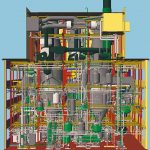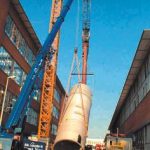The production of biopharmaceuticals on an industrial scale has long been – and continues to be – a daunting challenge for biotechnology. The optimised and efficient expression systems that are used have been adapted to growth in large-scale bioreactors. Growth, production, isolation and purification processes are tightly controlled to ensure product quality. Together with the specific requirements of each given process, current trends also point to a demand for highly controlled, flexible and modular production facilities.
Dr. Jan Carsten Hempel, Dr. Hiltrud Lenke
Biotech processes are primarily determined by the biological system used. Any specific requirements defined by the biology of the cell line or the microbial system must be considered in the design of a production facility. Production economy critically depends on the adaptation of the bioreactor design and the control of the cultivation parameters to the biological system. When it comes to downstream processing, harvesting, isolation and purification, the nature of the often highly sensitive biomolecules must be taken into account to prevent extended product decomposition and loss. Downstream proces-sing is crucial to consistent product quality and overall process economy.
A deep knowledge of the biological aspects and expertise in both process technology and engineering are essential to plan and realise a biotech facility. The project team, comprised of bioprocess and pharmaceutical engineers, attempts to solve the recurring questions arising from the realisation of a biotech project. This team is supported by specialists in architecture (zoning concepts, clean rooms), process automation, qualification and facility validation.
Process simulation
Facility planning also includes an assessment of the internal flow of goods. This can be most effectively achieved with process simulation tools. These simulations help optimise processes in the facility and ease the identification of potential bottlenecks, which then can be eliminated at an early planning stage. The result is a cost-efficient layout reflecting optimised needs for storage capacity, transportation, piping, pumping, etc. The simulation tool additionally provides details about cell culture, harvest, buffer and media preparation, CIP/SIP, high-purity media requirements, inactivation and disposal. Various scenarios for failures and accidents can also be simulated to indicate the critical parameters of a process design. The breakdown scenario for the purified water supply, for example, can be simulated and its impact on a current process analysed in detail.
Modern production facilities in the pharmaceutical industry demand a significant degree of flexibility to ensure maximum efficiency. Modular, multipurpose facilities best satisfy the requirements of changing production strategies. Yet these facilities are faced with the difficulty of optimising the complex interrelationships between occupancies, cleaning cycles and setup and batching processes. This can be extremely time-consuming without a powerful simulation tool. Process simulation is hence an important instrument for optimised sizing and cost-efficient operation of a facility.
Extensive expertise
Chemgineering has demonstrated its competence in this expanding market segment in numerous projects carried out over many years. Its track record includes renowned customers in areas such as vitamin production, purification of blood serum and the production of vaccines. The size of the facilities planned ranges from pilot scale units to plants capable of producing several tens of thousands of tons annually.
The production facility for vitamin B2 at Hoffmann-La Roche AG (now DSM Nutritional Products) is a good example of a large biotech facility planned by and constructed under the lead management of Chemgineering. The process is based on microbial production. The developed strain and process have resulted in a highly economical process that has replaced chemical synthesis. In addition to improving operating efficiency, waste quantities were significantly reduced (for further details, refer to “Weiße Biotechnik“ published by the Bavarian Institute of Applied Environmental Research and Technology).
The vitamin B2 facility is dedicated to the continuous production of two vitamin B2 products with an annual output of 3000 t. Planning the facility was a major challenge. Large items of equipment, including several big bioreactors with piping and a 30 m tall spray dryer had to be installed in an existing building, and the tight schedule dictated that all essential resources be pooled.
The complex production process was initially analysed and divided into small, self-contained work packages. This enabled the detailed planning to get under way after only a very short time. The criteria for this division included spatial separation, process-related separations, delivery schedule and earliest possible installation. The purpose of this approach was to identify those areas where basic planning could be completed fastest and detailed planning commenced soonest. Parallel work on the basic and detailed engineering for different work packages helped reduce the total planning time.
The early implementation of 3D-CAD facilitated precise planning and prefabrication of the piping. The precision of the prefabricated parts, which were characterised by a low margin of error, speeded up assembly on the construction site. The database behind this tool also generated the project planning documentation. As a result, Chemgineering was able to complete this project – involving the installation of over 500 items of equipment – after about 15 months of planning and less than a year of construction.
Bacterial vaccines
A different kind of challenge had to be mastered by the planning team at Chemgineering in connection with a production facility for bacterial vaccines. Vaccine production is the second fastest-growing segment in pharmaceutical biotechnology after the production of recombinant proteins. Immunisation can be achieved in various ways which are reflected in the production process. Bacterial cell surface antigens classically stimulate the immune response, causing the body to produce specific antibodies.
Production of vaccines derived from a bacterial cell surface antigen in a dedicated facility is comparatively straightforward. The design can be tailored to the respective process. Issues such as sterility are less complex than in multipurpose units, where flexible interaction of different processes is essential. A dedicated facility for just one product can therefore lead to cost benefits.
cpp 428
Directly to chemgineering
Industrial biotechnology
Achema 2006
Share:








